|
|
SEE LIST BELOW for open dates |
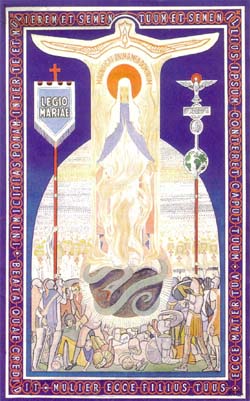 |
LEGION of MARY |
|
|
SEE LIST BELOW for open dates |
 |

Legion of MaryThe Legion of Mary (Latin: Legio Mariae) is an association of Catholic laity who serve the Church on a voluntary basis.[1] It was founded in Dublin, Ireland, as a Roman Catholic Marian Movement by layman Frank Duff. Today between active and auxiliary (praying) members there are in excess of 10 million members worldwide making it the largest apostolic organization of lay people in the Catholic Church.[2] Membership is highest in South Korea, Philippines, Brazil, Argentina and the Democratic Republic of Congo. These countries have between 250,000 and 500,000 members each.[3] To be in the Legion of Mary, one must be a practising Catholic. Active members serve God under the banner of Mary by practising the Spiritual Works of Mercy. The main apostolate of the Legion consists in activities directed towards all men and women, young and old, rich and poor as well as people from the margins of society (homeless, prostitutes, prisoners etc.) and towards non-Catholics. The members of the Legion are primarily engaged in the performance of the Spiritual Works of Mercy rather than works of material aid.[4]
History The Legion of Mary soon spread from Ireland to other countries and continents. At first, the Legion often met with mistrust due to its dedication to lay apostolate which was unusual for the time. Only after Pope Pius XI expressed praise for the Legion in 1931, could such mistrust be quelled. Most prominent for spreading the Legion was the Irish legionary Edel Mary Quinn for her activities in Africa during the 1930s and 40s. Her dedication to the mission of the Legion even in the face of her ill health due to tuberculosis brought her great admiration in- and outside of the Legion. A canonization process is currently under way for Edel Quinn and a beatification process is currently underway for Frank Duff. Membership in Ireland had been declining but due to efforts by the Concilium to attract younger people to its ranks through the Deus et Patria movement a substantial increase in membership has now occurred. The System of the Legion - StructureThe organization of the Legion is modelled on the Roman Army, starting with the praesidium as its smallest unit, and going up from there. The praesidium, usually a group of 4-20 members, meets weekly in its parish. The Curia is the next level up, and one Curia supervises several Praesidia. The next level is the Comitium, which is in charge of several Curiae, usually over an area like a big city or a part of a province. The following level is the Regia, in charge of larger territories like a province or state (in the U.S.). The Senatus is the next highest level, and it generally has control over the Regiae in a very large area, usually a country or very large territory. The Concilium is the highest level. It has its seat in Dublin, Ireland, and has control over all of the Legion. Each level of the Legion of Mary has the same officers: The President, the Vice President, the Secretary, the Treasurer, and the Spiritual director. The latter must be a priest or a religious. All other offices are held by laymen or -women. Membership - Entering and leaving the LegionMembership is open to all baptized Catholics. After visiting a praesidium a few times, one can join the legion as a probationary member. This probationary membership lasts for three months, after which he or she has to decide whether to join the Legion as an active member permanently. During the probationary period, probationary members learn about the legion system by reading the Handbook of the Legion of Mary and its active works by listening to reports of active works undertaken by fellow legionaries. At the end of probationary period, members say an oath of "Legion promise", a pledge of allegiance to the Holy Spirit and to Mary, in order to become a permanent active member. Membership in the Legion of Mary is essentially based on discipline and commitment. Members devote their time and prayer for the intentions of Mary, Mother of God. Members can withdraw from the Legion by informing the president of his or her praesidium. Types of membershipActive members: They regularly attend the weekly sessions of their praesidium and pray daily the prayer of the Legion, the Catena Legionis, which consists essentially of the Magnificat and some shorter prayers. Their main role lies in active apostolate for the Legion and the Church. Active members under the age of 18 are not allowed to give the "Legion promise" until they turn 18. Members 18 and under are considered Juniors, and are able to hold any office except President in their praesidium. Above the level of the praesidium, no Junior may serve as an officer. Auxiliary members: They support the Legion through their prayer. They pray the whole booklet of Legion prayers, the Tessera, every day. The Tessera consists of the Invocation, prayers to the Holy Spirit, the Rosary, the Catena, and the concluding prayers of the Tessera. Praetorians: This is a higher grade of active membership. In addition to their duties as active members, Pretorians pray the Rosary, the Divine Office and go to Holy Mass daily. Adjutorians: A higher grade of auxiliary membership. Adjutorians additionally pray the Divine Office and go to Holy Mass daily. Praetorians and Adjutors do not have higher status or higher rank inside the Legion system. The meaning of these grades is only a desire for a more devotional life, not for higher status. Entering the grade is done by registering with a list of Praetorians/Adjutors and by subsequently observing their duties.
Legion meetings
|
|
|
|
| This picture was taken at a Legion of Marry
conference in the Philippines 1990. Notice Mary image , lower left, imposed on the vial of one for the four ladies at the bottom of the picture There is no image of Mary in that configuration any where else in the room , so it is not a reflection. No one knows how the image got there.
The Crown is smaller that others , tilted but her head is not
tilted as other are. No cover on her head, or it is a black veil. |
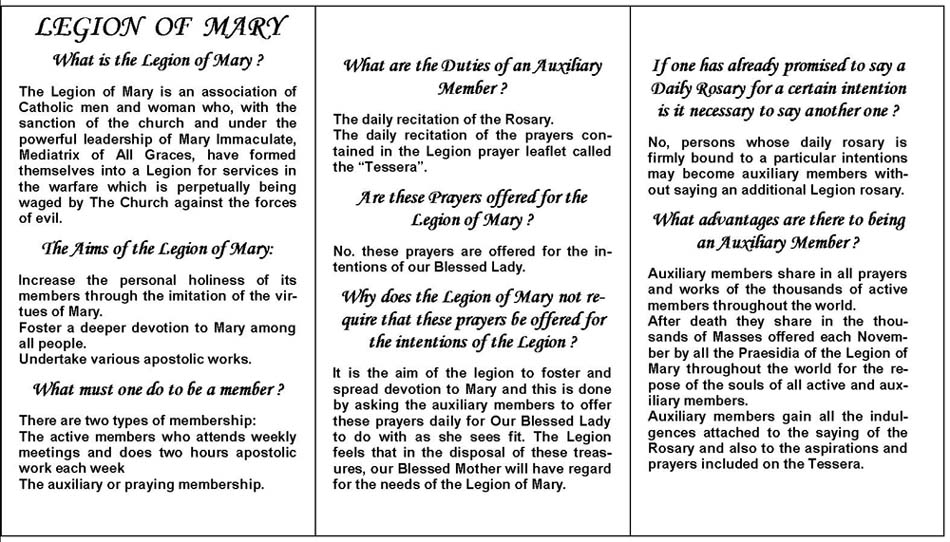
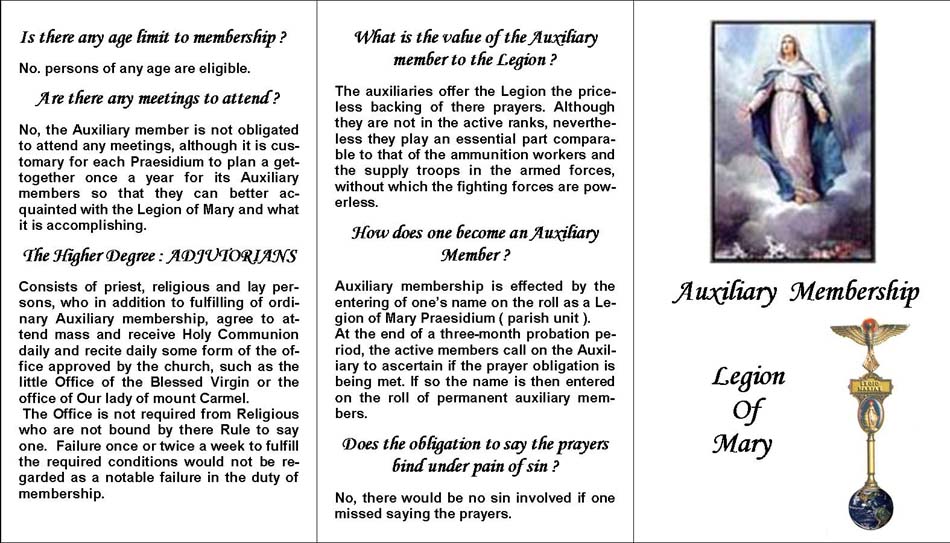
|
|
 |
|
 |
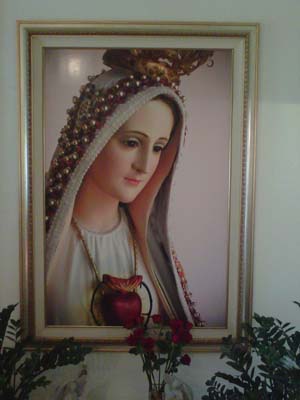 |
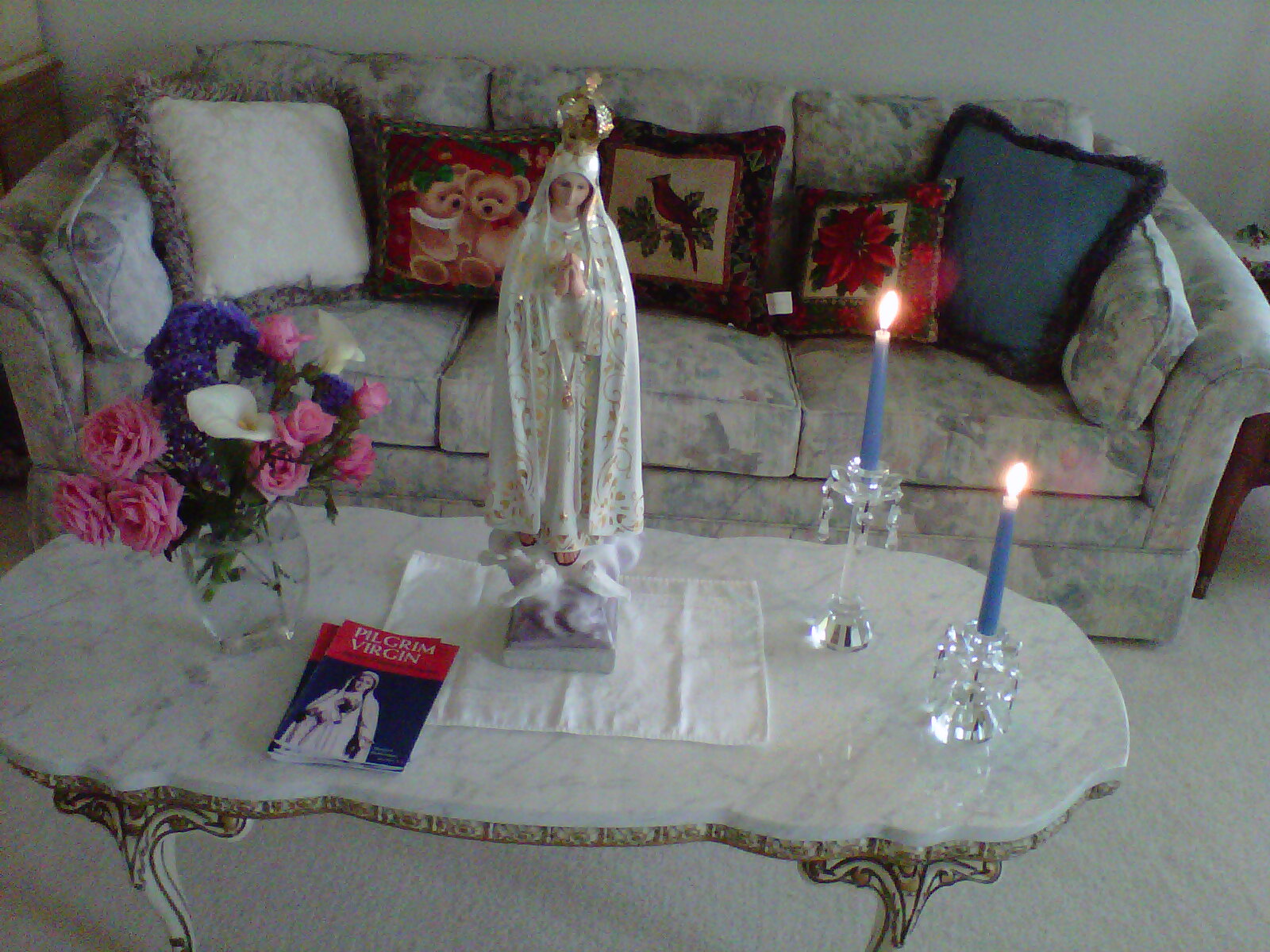 |
|
|
| LEGION of MARY HOLY SPIRIT CHURCH |
| started Dec.6 2010 |
Hit count
See Acknowledgements page
44 different countries have visited this site.